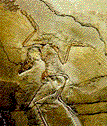Advertisement.
EnchantedLearning.com is a user-supported site.
As a bonus, site members have access to a banner-ad-free version of the site, with print-friendly pages.
Click here to learn more.
(Already a member? Click here.)
Click on an underlined word for more information on that subject.
If the dinosaur or paleontology term you are looking for is not in the dictionary, please e-mail us.
Archaeopteryx
 Archaeopteryx (meaning "ancient wing") is a very early prehistoric bird, dating from about 150 million years ago during the Jurassic period, when many dinosaurs lived. It is one of the oldest-known birds.
Archaeopteryx (meaning "ancient wing") is a very early prehistoric bird, dating from about 150 million years ago during the Jurassic period, when many dinosaurs lived. It is one of the oldest-known birds.
Archaeopteryx seemed to be part bird and part dinosaur. Unlike modern-day birds, it had teeth, three claws on each wing, a flat sternum (breastbone), belly ribs (gastralia), and a long, bony tail. Like modern-day birds, it had feathers, a lightly-built body with hollow bones, a wishbone (furcula) and reduced fingers. This crow-sized animal may have been able to fly, but not very far and not very well. Although it had feathers and could fly, it had similarities to dinosaurs, including its teeth, skull, lack of horny bill, and certain bone structures. Some paleontologists think that Archaeopteryx was a dead-end in evolution and that the maniraptors (a group of dinosaurs that included the Dromaeosaurs Deinonychus, Utahraptor, and Velociraptor) led to the birds.
Amazingly detailed Archaeopteryx fossils have been found in fine-grained Jurassic limestone in southern Germany. This fine-grained limestone is used in the lithographic process, hence the species name "lithographica" given to the early Archaeopteryx specimen. The first Archaeopteryx fossil (a feather) was found in 1860 near Solnhofen, Germany, and was named by the German paleontologist Hermann von Meyer in 1861. A total of seven Archaeopteryx specimens have been found, plus the feather.
In 1868, Thomas Henry Huxley interpreted the Archaeopteryx fossil to be a transitional bird having many reptilian features. Using the fossils of Archaeopteryx and Compsognathus, a bird-sized and bird-like dinosaur, Huxley argued that birds and reptiles were descended from common ancestors. Decades later, Huxley's ideas fell out of favor, only to be reconsidered over a century later (after much research and ado) in the 1970's.
Bird fossils are rare because bird bones are hollow and fragile, and usually deteriorate instead of fossilizing. However, a few Jurassic, mid-Cretaceous, Eocene and Miocene-Pliocene bird fossils have been found.
LINKS:
A page on Archaeopteryx at the UCMP, Berkeley.
The 1861 Archaeopteryx fossil from the Linda Hall Library.
Archaeopteryx from the Talk Origins web site.
Archaeopteryx from Dinosauria online, by Thomas Holtz, Jr.
Enchanted Learning®
Over 35,000 Web Pages
Sample Pages for Prospective Subscribers, or click below
Click to read our Privacy Policy
Enchanted Learning Search
|
Search the Enchanted Learning website for:
|
Advertisement.
Advertisement.
Copyright ©1996-2018
EnchantedLearning.com ------ How to cite a web page

